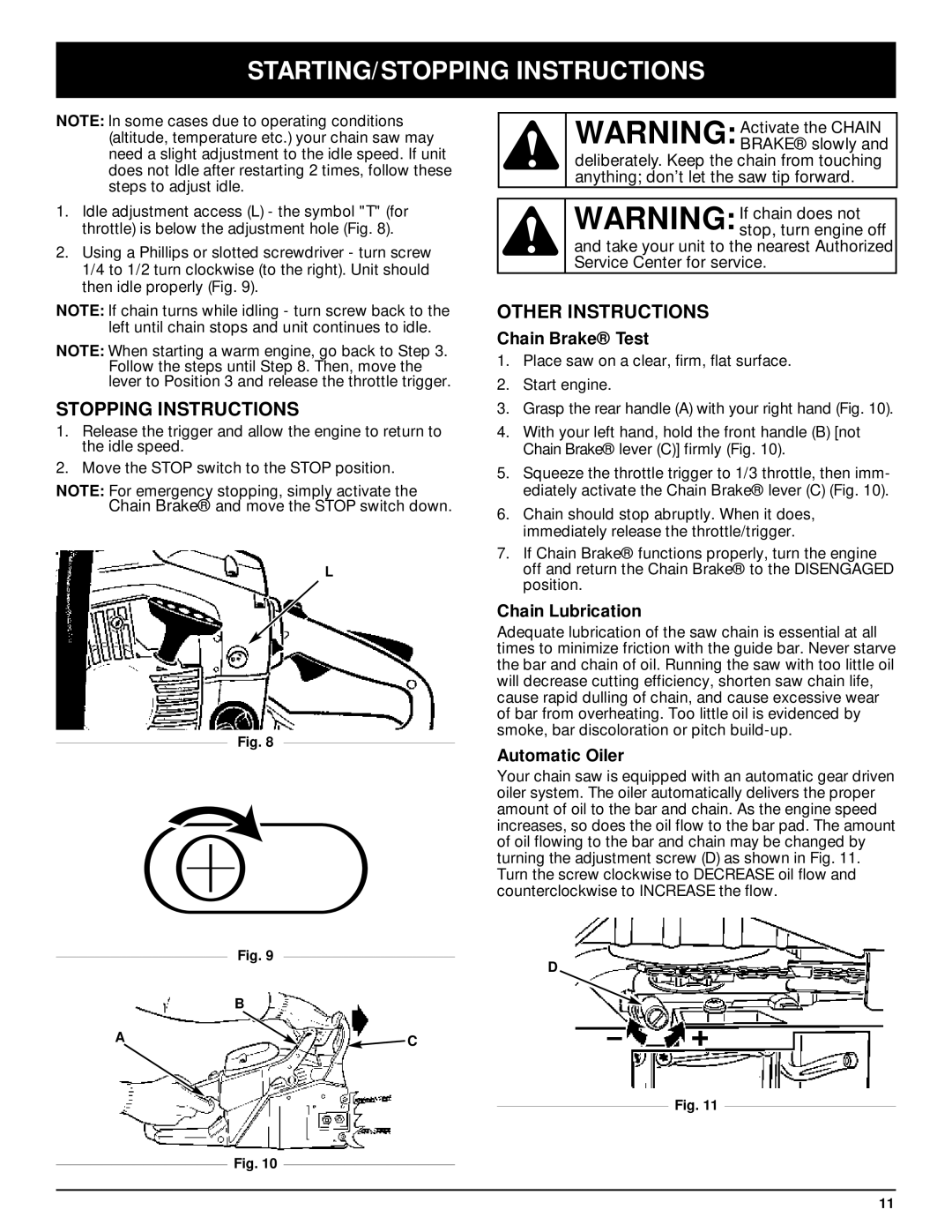
STARTING/STOPPING INSTRUCTIONS
NOTE: In some cases due to operating conditions (altitude, temperature etc.) your chain saw may need a slight adjustment to the idle speed. If unit does not Idle after restarting 2 times, follow these steps to adjust idle.
1.Idle adjustment access (L) - the symbol "T" (for throttle) is below the adjustment hole (Fig. 8).
2.Using a Phillips or slotted screwdriver - turn screw 1/4 to 1/2 turn clockwise (to the right). Unit should then idle properly (Fig. 9).
NOTE: If chain turns while idling - turn screw back to the left until chain stops and unit continues to idle.
NOTE: When starting a warm engine, go back to Step 3. Follow the steps until Step 8. Then, move the lever to Position 3 and release the throttle trigger.
STOPPING INSTRUCTIONS
1.Release the trigger and allow the engine to return to the idle speed.
2.Move the STOP switch to the STOP position.
NOTE: For emergency stopping, simply activate the Chain Brake® and move the STOP switch down.
L
Fig. 8
| Fig. 9 |
| B |
A | C |
WARNING: Activate the CHAIN BRAKE® slowly and
deliberately. Keep the chain from touching anything; don’t let the saw tip forward.
WARNING: If chain does not stop, turn engine off
and take your unit to the nearest Authorized Service Center for service.
OTHER INSTRUCTIONS
Chain Brake® Test
1.Place saw on a clear, firm, flat surface.
2.Start engine.
3.Grasp the rear handle (A) with your right hand (Fig. 10).
4.With your left hand, hold the front handle (B) [not Chain Brake® lever (C)] firmly (Fig. 10).
5.Squeeze the throttle trigger to 1/3 throttle, then imm- ediately activate the Chain Brake® lever (C) (Fig. 10).
6.Chain should stop abruptly. When it does, immediately release the throttle/trigger.
7.If Chain Brake® functions properly, turn the engine off and return the Chain Brake® to the DISENGAGED position.
Chain Lubrication
Adequate lubrication of the saw chain is essential at all times to minimize friction with the guide bar. Never starve the bar and chain of oil. Running the saw with too little oil will decrease cutting efficiency, shorten saw chain life, cause rapid dulling of chain, and cause excessive wear of bar from overheating. Too little oil is evidenced by smoke, bar discoloration or pitch
Automatic Oiler
Your chain saw is equipped with an automatic gear driven oiler system. The oiler automatically delivers the proper amount of oil to the bar and chain. As the engine speed increases, so does the oil flow to the bar pad. The amount of oil flowing to the bar and chain may be changed by turning the adjustment screw (D) as shown in Fig. 11. Turn the screw clockwise to DECREASE oil flow and counterclockwise to INCREASE the flow.
D
Fig. 11
Fig. 10
11
